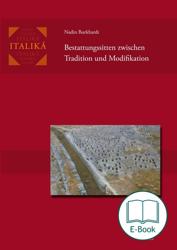This study focuses on cultural exchange and aspects of acculturation, which go back to the Greek settlement in Lower Italy and Sicily and result from the coexistence of the Italic and Sicilian population and the Greek settlers.
The development of tomb types, funerary goods and funeral rites is used to study diverse influences such as the relations between the colony and the motherland, among the colonies themselves as well as between the colonies and their surrroundings and the people living nearby. The study uses three case studies – the Euboean settlements Pithecoussai and Kyme in Campania, the Achaean colony Metapontion and the Spartan city of Taras in Lower Italy, and the Rhodian-Cretan colonies Gela and Akragas in Sicily.
This study focuses on cultural exchange and aspects of acculturation, which go back to the Greek settlement in Lower Italy and Sicily and result from the coexistence of the Italic and Sicilian population and the Greek settlers.
The development of tomb types, funerary goods and funeral rites is used to study diverse influences such as the relations between the colony and the motherland, among the colonies themselves as well as between the colonies and their surrroundings and the people living nearby. The study uses three case studies – the Euboean settlements Pithecoussai and Kyme in Campania, the Achaean colony Metapontion and the Spartan city of Taras in Lower Italy, and the Rhodian-Cretan colonies Gela and Akragas in Sicily.
There is no homogeneous process which is the same in all colonies, but specific local developments which result from the different activities of cultural groups in the area, the structure of the Greek colonists’ society, the location and development of the colony and the natural environment.
In all three of the areas studied, the Greek influence is visible in the indigenous funeral culture; however, no simple adoption of Greek customs can be observed. The “idea”, the particular ritual or tomb type and the need to use it, and also to utilise it for the visualisation of different social groups, goes back to the direct contact caused by the foundation of colonies. The respective manifestation and form are then developed in the cultural framework of the indigenous people.
The dissertation is published as the second volume in the newly established series “Italiká”, which focuses entirely on the archaeology of pre-Roman Italy with all the research areas connected with it, and thereby responds to a current and constantly growing research interest. “Italiká” will comprise monographies and thematically unified collections from all areas of classical studies broadly dealing with sources, features and findings on the population of the territory of modern Italy in pre-Roman times, and which offer methodically and theoretically innovative approaches that illuminate exemplarily the panoply of a complex world of cultural contact.
„Mit ihrer groß angelegten Synthese hat Nadin Burkhardt eine Arbeit mit Handbuchcharakter vorgelegt, die einen quellen- und literaturgesättigten Überblick bietet und auch für Teilbereiche bequem zu konsultieren ist.“
Matthias Hoernes
In: Göttinger Forumg für Altertumswissenschaften 18, 2015, 1021-1030.
--------------------------------------------
„Viele Besonderheiten des Bestattungswesens lassen sich weder durch Rückbezüge aus der Heimat der Kolonisten noch durch Einflüsse von den einheimischen Kulturen Italiens allein erklären. Vielmehr zeigt sich, und das ist das nicht geringe Verdienst der vorliegenden Arbeit, dass die Bestattungssitten in den Kolonien von Beginn weg eigenständige Wege gehen, geprägt von den neuen Lebensumständen der Kolonisten, den spezifischen naturräumlichen Gegebenheiten und dem Bestattungsverhallen der einheimischen und griechischen Nachbarn“
Martin A. Guggisberg
In: Museum Helveticum, Vol. 72, Fas. 1, 2015, S. 109.
Nadin Burkhardt
absolvierte ihr Studium der Klassischen Archäologie, der Kunstgeschichte und der Archäologie der römischen Provinzen in Berlin, Paris und Köln. Im März 2008 erfolgte die Promotion an der Universität Köln mit der Arbeit „Zwischen Tradition und Modifikation. Kulturelle Austauschprozesse in den Bestattungssitten der griechischen Kolonien in Unteritalien und Sizilien vom 8. bis zum 5. Jahrhundert v. Chr.“
Zwischen 2004 und 2008 arbeitete und forschte sie als wissenschaftliche Mitarbeiterin im Fachgebiet Klassische Archäologie am Fachbereich Architektur an der TU Darmstadt, sowie als Stipendiatin im Schwerpunktprogramm „Italische Kulturen vom 7. bis 3. Jahrhundert v. Chr. in Unteritalien und Sizilien“ am Deutschen Archäologischen Institut in Rom und als Koordinatorin im Schwerpunktprogramm 1171 „Frühe Zentralisierungs- und Urbanisierungsprozesse. Zur Genese und Entwicklung frühkeltischer Fürstensitze“ am Landesamt für Denkmalpflege am Regierungspräsidium Stuttgart. Seit November 2008 ist sie wissenschaftliche Assistentin in der Klassischen Archäologie am Institut für Archäologische Wissenschaften an der Johann-Wolfgang-Goethe-Universität in Frankfurt am Main.
Zu ihren Grabungstätigkeiten gehören die Mitarbeit bzw. eigenständige Projekte in Marzabotto (Italien), in Gadara/Umm Qais (Jordanien) und in Priene (Türkei). Forschungsschwerpunkte bilden die griechische Kolonisation im Westen, Diasporasynagogen im Mittelmeerraum und die spätantike Stadtentwicklung in Griechenland.
Herausgeber:
Nadin Burkhardt
Henner von Hesberg
Erich Kistler
Alessandro Naso
Richard Neudecker
Christina Nowak
Ellen Thiermann


 Preface
Preface